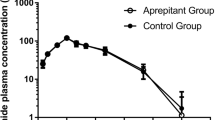Abstract
Selective 5-HT3 antagonists have proven to be safe and effective for the prevention of chemotherapy-induced nausea and vomiting. Dolasetron is a new highly selective addition to this class of antiemetics that has been shown to have significant antiemetic activity in patients receiving cisplatin-containing regimens. This pilot study was designed to evaluate the antiemetic efficacy of dolasetron in cancer patients receiving doxorubicin and/or cyclophosphamide. This study used an openlabel, non-randomized design to evaluate the efficacy and safety of intravenous dolasetron in the prevention of emesis in patients receiving doxorubicin (25–75 mg/m2) and/or cyclophosphamide (400–1200 mg/m2). Sixty-nine patients received a single, intravenous dose of dolasetron over 15–20 min beginning 30 min prior to the start of chemotherapy. Dose levels of dolasetron studied were: 0.3, 0.6, 1.2, 1.8 and 2.4 mg/kg. Patients were monitored for emesis, nausea and adverse events for 24 h after the start of chemotherapy. Overall, 61% of patients experienced complete control of emesis. No significant trend towards increased antiemetic efficacy (P = 0.076) or nausea control with increasing dolasetron dose was noted, although the power to detect significant differences was limited by the small number of patients on the 0.3-mg/kg and 2.4-mg/kg dose levels. Age, gender, and type of chemotherapy were significant predictors of complete antiemetic control. Adverse events were generally mild and included headache, chills, light-headedness, fever, diarrhea, dizziness, and asymptomatic prolongation of ECG intervals. Intravenous dolasetron is safe and effective in the prevention of emesis induced by doxorubicin and/or cyclophosphamide.
Similar content being viewed by others
References
Baltzer L, Kris MG, Hinkley L, et al (1994) Reversible electrocardiographic interval prolongations following the specific serotonin antagonists ondansetron (OND) and dolasetron mesylate (DM): a possible drug class effect without sequelae? (abstract). Proc Am Soc Clin Oncol 13:433
Beck TM, Ciociola AA, Jones SE, et al (1993) Efficacy of oral ondansetron in the prevention of emesis in outpatients receiving cyclophosphamide-based chemotherapy. Ann Intern Med 118:407–413
Boeijinga PH, Galvan M, Baron BM, Dudley MW, Siegel BW, Slone AL (1992) Characterization of the novel 5-HT3 antagonists MDL 73147EF (dolasetron mesylate) and MDL 74156 in NG108-15 neuroblastoma x glioma cells. Eur J Pharmacol 219:9–13
Boxenbaum H, Gillespie T, Heck K, Hahne W (1992) Human dolasetron pharmacokinetics. I. Disposition following single-dose intravenous administration to normal male subjects. Biopharm Drug Dispos 13:693–701
Clark R, Tyson L, Frisone M (1985) A correlation of objective (OBJ) and subjective (SUBJ) parameters in assessing antiemetic regimens (AER). Oncol Nurs Forum 12 [Suppl]: 96
Conroy T, Cappelaere P, Fabbro M, et al (1994) Acute antiemetic efficacy and safety of dolasetron mesylate, a 5-HT3 antagonist, in cancer patients treated with cisplatin. Am J Clin Oncol 17:97–102
Dixon R, Cramer M, Conway DW, et al (1995) Single-dose, placebo-controlled phase I study of oral dolasetron. Pharmacotherapy (in press)
Galvan M, Gittos MW, Miller RC, Moser PC, Giersbergen PLM van, Fozard JR (1992) Dolasetron mesilate (MDL 73147EF), a potent anti-emetic 5-HT3 receptor antagonist (abstract). Br J Pharmacol 107 [Suppl]:449P
Gittos MW, Fatmi M (1989) Potent 5HT3 antagonists incorporating a novel bridged pseudopelletierine ring system. Actual Chim Ther 16:187–189
Grunberg SM, Hesketh PJ (1993) Control of chemotherapy-induced emesis. N Engl J Med 329:1790–1796
Hesketh PJ, Gandara DR (1991) Serotonin antagonists: a new class of antiemetic agents. J Natl Cancer Inst 83:613–620
Hunt TL, Cramer M, Shah A, Stewart W, Benedict CR, Hahne WF (1995) A double-blind, placebo-controlled, dose-ranging safety evaluation of single-dose intravenous dolasetron in healthy male volunteers. J Clin Pharmacol 35:705–712
Kris MG, Gralla RJ, Clark RA, Tyson LB, Groshen S (1987) Antiemetic control and prevention of side effects of anti-cancer therapy with lorazepam or diphenhydramine when used in combination with metoclopramide plus dexamethasone: a double-blind, randomized trial. Cancer 60:2816–2822
Kris MG, Grunberg SM, Gralla RJ, et al (1994) Dose-ranging evaluation of the serotonin antagonist dolasetron mesylate in patients receiving highdose cisplatin. J Clin Oncol 12:1045–1049
Lifsey DS, Gralla RJ, Clark RA, Kline RC (1993) Electrocardiographic changes with serotonin antagonist antiemetics: rate of occurrence and clinical relevance (abstract). Proc Am Soc Clin Oncol 12:463
Miller RC, Galvan M, Gittos MW, Giersbergen PLM van, Moser PC, Fozard G (1993) Pharmacological properties of dolasetron, a potent and selective antagonist at 5-HT3 receptors. Drug Dev Res 28:87–93
Plezia P, Modiano M, Alberts D, et al (1992) A double-blind, randomized, parallel study of two doses of intravenous (IV) MDL 73,147EF in patients (PTS) receiving high dose cisplatin (CDDP)-containing chemotherapy (CT) (abstract). Proc Am Soc Clin Oncol 11:407
Williams PD, Cohen ML, Turk JA (1991) Electrocardiographic effects of zatosetron and ondansetron, two 5-HT3 receptor antagonists, in anesthetized dogs. Drug Dev Res 24:277–284
Author information
Authors and Affiliations
Rights and permissions
About this article
Cite this article
Hesketh, P.J., Gandara, D.R., Hesketh, A.M. et al. Dose-ranging evaluation of the antiemetic efficacy of intravenous dolasetron in patients receiving chemotherapy with doxorubicin or cyclophosphamide. Support Care Cancer 4, 141–146 (1996). https://doi.org/10.1007/BF01845763
Issue Date:
DOI: https://doi.org/10.1007/BF01845763




